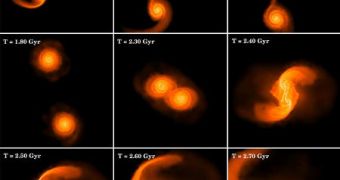A team of astrophysicists believes it may have discovered the origins of the impressively-large black holes that reside at the core of massive galaxies such as the Milky Way.
According to the newest data, it would appear that galaxy collisions that took place in the early Universe are responsible for merging primitive black holes into the dark behemoths we see today.
The new data were derived by researchers at the Ohio State University (OSU), who ran a very complex simulation on a supercomputer to make the discovery.
One of the main ideas supporting the new theory is the fact that supermassive black holes have already been discovered to exist very early in the Universe, something that current astronomical models don't allow for.
The discoveries imply that it takes a lot less for the structures to form than initially believed. This is in itself a feat, considering that many of these dark behemoths have millions to billions of time the mass of our Sun.
Black holes form when massive stars reach the end of their burning cycle, and then collapse onto themselves after exhausting their hydrogen fuel supply.
As this happens, the entire core of the star is compressed into a very small space, which features impressive gravitational pull. Its influence on surrounding matter is so large that it can even engulf light.
To get an idea of how compressed and crushed matter in such a space structure is, imagine that Earth and everything on it would need to be reduced to the size and diameter of a tennis ball in order to behave like a black hole.
Now researchers believe that collisions which took place between early galaxies led to the smaller black holes at their cores merging into larger structure.
It would appear under the new model that it takes as little as 100 million years to produce a supermassive black hole, the research team says.
“Our result shows that big structures, both galaxies and massive black holes, build up quickly in the history of the universe,” explains OSU astronomer Stelios Kazantzidis.
He is also the coauthor of a new paper detailing the findings, which is published in the August 26 issue of the esteemed scientific journal Nature, Space reports.
“For example, the standard idea that a galaxy's properties and the mass of its central black hole are related because the two grow in parallel will have to be revised,” the expert adds.
“In our model, the black hole grows much faster than the galaxy. So it could be that the black hole is not regulated at all by the growth of the galaxy. It could be that the galaxy is regulated by the growth of the black hole.” he concludes.

 14 DAY TRIAL //
14 DAY TRIAL //